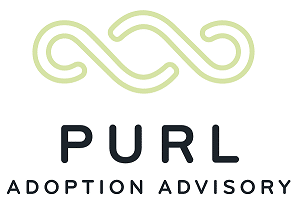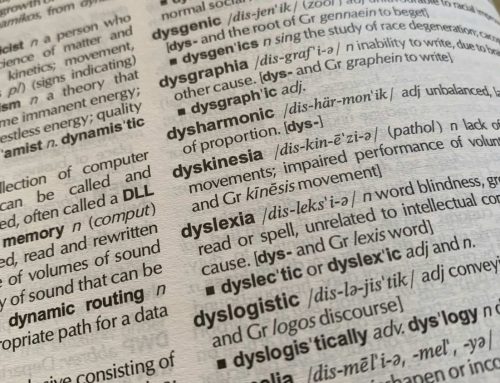
Interested in adoption but overwhelmed about all the jargon and legal terms? As a mom through adoption who once was in your shoes, I know how intimidating it can be at the beginning of the process. Here are some common terms used in domestic infant adoption and what they typically mean within the adoption community (although the law is different in each state and terms can be used differently depending on where you are located):
1. Adoptee: This refers to a person who has been adopted, also known as an adopted child.
2. Adoption: The complete transfer of parental rights and obligations from one parent or set of parents to another. A legal adoption requires court action.
3. Adoption Agency: An organization, usually licensed by the state it operates in, to place children for adoption. Agencies may be public or private, secular or religious, for-profit or non-profit. Some states require that a licensed agency be involved in the placement of a child for adoption (often called an “Agency State”).
4. Adoption Attorney: An attorney who is licensed to practice law in one or more states, who files, processes and finalizes adoptions in court. In some states attorneys may also arrange adoption placements or “match” expectant parents with hopeful adoptive parents.
5. Adoption Advisor: Sometimes referred to as an “Adoption Guide”, “Adoption Coach” or “Adoption Planner”. An individual who guides, advocates and assists prospective adoptive parents through the adoption process, and assists in the selection of appropriate agencies and attorneys. Adoption Advisors, as opposed to Adoption Facilitators, do not have contact with expectant parents and do not locate or obtain a child for adoption.
6. Adoption Certification: Sometimes referred to as “Pre-Adoption Certification” or “Home Study Approved”. Most states require adoptive couples in their state to be evaluated for their suitability to adopt. This certification involves a home study of the adoptive parents, including an investigation of their health, finances, criminal background and possible history of child abuse or domestic violence. Most certifications take an average of 3-5 months and once awarded are valid for one year to eighteen months, depending on the state, but can typically be updated or renewed for a longer period of time. States like Arizona actually require that the home study be submitted to the court to receive Certification to Adopt.
7. Adoption Facilitator: Individuals that are not licensed as adoption agencies or licensed as attorneys, and who are engaged in the matching of expectant parents with adoptive parents, typically for a fee. Paid facilitators are illegal in most states, except notably California and Pennsylvania. An improper use of a paid Adoption Facilitator could have a detrimental impact on the finalization of an adoption.
8. Adoption Plan: An expectant parent’s decision to allow their child to be placed for adoption. A formal Adoption Plan may include i) the identity of the individuals or family that will adopt the child, or how those individuals will be selected; ii) The type of adoption (i.e. closed adoption, a semi-open adoption or an open adoption); iii) how the medical and living expenses of the expectant mother will be paid; iv) how the birth parents and the adoptive parents will be involved with each other after the adoption, including the nature and frequency and type of contact; v) which adoption attorney or adoption agency will provide assistance in obtaining the necessary adoption consents or relinquishments, and finalizing the adoption.
9. Adoption Triad: A term used to describe the three-sided relationship that exists in an adoption between the birth parents, adoptive parents and the adoptee.
10. Agency Placement: An adoption where the adoption consent is given to an agency, rather than directly to an adoptive family.
11. Birth Father: The biological father of a child that has been placed for adoption. In an adoption proceeding there can be a putative birth father and a legal birth father, both defined below.
12. Birth Mother/Expectant Mother: A woman who is pregnant and is considering adoption for her child after she gives birth. Recently it has become preferable to refer to the woman as expectant mother until she consents to the adoption, and at that time she becomes the birth mother.
13. Closed Adoptions: This type of adoption is used rarely today in domestic adoptions, but was traditionally the type of adoptions seen before the 1980s. In these adoptions, the birth family and the adoptive family do not share typically share any identifying information about themselves, and do not communicate with each other, either before or after the placement of the child. The adoptive family may receive some non-identifying health and other background information about the child and the birth family before the placement takes place. The birth parents may also receive non-identifying information about the adoptive parents.
14. Certificate of Adoption: This is the official document that is signed by the Judge at the time of the finalization of the adoption, which allows a new birth certificate to be issued for the adopted child by the Department of Vital Records, typically showing the adoptive parents as though they were the original biological parents of the child.
15. Consent to Adopt: The document that is voluntarily signed by the birthparents that allows the adoptive parents to adopt their child. In most states it must be signed in front of witnesses and a Notary Public. State law varies widely concerning when the earliest point in time is when a binding Consent may be signed by a birth parent. In some states a consent is irrevocable when signed, meaning it cannot later be taken back or voided by a birthparent, unless it can be shown that it was executed in an improper form or way, or at an improper time, or that it was obtained as the result of fraud, misrepresentation, force or duress.
16. Decree of Adoption: The document that a judge signs to finalize an adoption. It formally creates the parent-child relationship between the adoptive parents and the adopted child. It places full responsibility for the child on its adoptive parents and typicaly changes the name of the child to the name selected by its adoptive parents.
17. Department of Vital Records: The government department in each state that issues and maintains the official birth certificates and death certificates of individuals that were born or died in that state. In some states this department also administers a putative father registry.
18. Direct Placement Adoption: An adoption possible in some states where one or more of the consents are given directly to an adoptive parent, rather than first to an agency, who then consents to an adoptive parent.
19. Disrupted Adoption: Often called a “Failed Adoption”. This term generally refers to an adoption that for some reason has not become final, even though the adoptive parents were identified as the parents to adopt the child and the child may have even been placed in their home for a period of time.
20. Domestic Adoption: An adoption that involves adoptive parents and a child that are citizens and residents of the United States.
21. Emergency Placement: Often called a “stork-drop” or “baby born case”. An adoption match that is made after the child has already been born.
22. Family Profile: Also referred to as an “adoptive parent profile,” or an “adoption profile”. It is a document (electronic or printed) that gives background and current information about a parent that desires to adopt a child. It is intended to contain information that will be provided to expectant parents to assist them in selecting adoptive parents to adopt their child. Typically, a Family Profile will include a narrative description of the hopeful adoptive parent or adoptive family, statistical information, such as age, educational and employment background, and talents and hobbies, plus a letter addressed to the expectant families considering an adoption plan for their child.
23. Finalization Hearing: A court hearing where in most states an adoption becomes final. Usually, the adoptive parents and the child to be adopted go to court with their lawyer and provide testimony to the court regarding the appropriateness of the adoption, but sometimes these hearings happen virtually or telephonically. If the judge is satisfied that all legal requirements have been met, and that the adoption would be in the best interests of the child, the Decree of Adoption will be signed, finalizing the adoption, and the Certificate of Adoption will be signed and transmitted to the Department of Vital Records, so that the child’s new birth certificate can be created and issued.
24. Finalization: The point in time when the court grants the Petition to Adopt of the adoptive parents and takes the necessary action to formally make the child a legal member of their family.
25. Interstate Compact on the Placement of Children (ICPC): Any adoption placement that involves a child outside of your state of residence will involve an agreement enacted by all 50 U.S states, the District of Columbia and the Virgin Islands called the Interstate Compact on the Placement of Children (ICPC). Adoptive parents may not travel back to their state of residence with the child they are adopting until they receive ICPC approval. In general, if the materials have been prepared properly and absent any other complications, adoptive parents typically receive ICPC approval within 7-10 business days of submission of the ICPC documents.
26. Irrevocable Consent: A term used to describe a Consent to Adoption that has been signed by the biological parent of a child that is being placed for adoption, which under state law cannot be revoked after it is signed, unless the court specifically finds that the Consent to Adoption was obtained by fraud or misrepresentation, or by the use force or undue duress on the birth parent.
27. Legal Father: Refers to a man recognized by law as the male parent of a child. State law differs on this but typically a man is considered the legal father of a child if i) he was married to the child’s natural mother when the child was born; ii) he has recognized or acknowledged the child (i.e. named on the birth certificate); or iii) if he has been declared the child’s natural father in a paternity action.
28. Legal Publication: Within our constitutionally based legal system, in order for parental rights of birthparents to be terminated in a legal proceeding, like an adoption, the affected individuals must be given adequate notice of the legal proceeding, and a reasonable opportunity to present evidence and witnesses in their own defense. When personal service is not possible because the affected individual cannot be located, the law allows the required notice to be published in a newspaper of general circulation that services the last know location of that individual. If this is done correctly, this publication will constitute valid legal notice.
29. Open Adoption: A type of adoption that has increased in popularity since the 1980s, becoming widely available in the late 1990s. Both identifying and non-identifying information about the adoptive parents and the birth parents is typically shared with each other, which may include last names, addresses, and telephone numbers. Open adoption typically involves meeting sometime before or at the birth, and remaining in contact after placement through letters, pictures, other forms of communication, and can include visits.
30. Petition to Adopt: This is the document that is filed with the court on an adoptive parent’s behalf to commence the adoption proceeding. It states the legal basis for the adoptive parent to adopt this child, why the court has jurisdiction to grant the adoption, the qualifications of the adoptive parent to adopt this child and the name that will be given to the child when the requested adoption becomes final.
31. Post-Adoption Contact Agreement: An agreement which is typically signed at the same time the adoption consent is signed. It allows for certain, specified contact between the signing birth parent(s) and the adoptive family. Some states will enforce such agreements so long as they serve the best interest of the adoptee while other states either prohibit or do not enforce them under any circumstances.
32. Post-Placement Supervision: This term refers to the services provided by an adoption caseworker between the time that a child is placed in the home of his or her prospective adoptive parents, and the time that the child’s adoption is finalized in court. The caseworker that is assigned to do the post-placement supervision of the adoptive parents will typically visit the adoptive family’s home during this period, which will generally be somewhere between 3 and 12 months, depending on the legal requirements in that state.
33. Putative Father Registry: Many states contain this type of a public registry, usually administered by the state’s Department of Vital Records, where an unmarried man who believes that he is the father of a child, may register and claim to be the father of this child. In order to register in the Registry, an alleged father must also agree to become financially responsible for the care of the child. A putative father that has properly registered in the registry can usually object to the placement of his child for adoption, if he meets certain requirements that are also imposed on him by state law.
34. Putative Father: A man whose legal relationship to a child has not been established but who is alleged to be or claims that he may be the biological father of a child who is born to a woman to whom he is not married at the time of the child’s birth.
35. Semi-Open Adoptions: A form of adoption that is intentionally designed to be a combination of a more traditional closed adoption and an open adoption and is still used today. Direct communication after the adoption is more limited, in the fashion that is agreed by the parties. Last names, addresses, and telephone numbers are usually not exchanged, while the sharing of photographs or other information for an agreed frequency and duration is common. Communication sometimes takes place through a third party, which is usually an adoption agency, an adoption attorney or a designated intermediary.
36. Termination of Parental Rights: In some states the term that is used is the “Severance of Parental Rights.” The process by which a parent’s rights to his or her child are legally and permanently terminated, after which the child becomes eligible for adoption.
If you or someone you know is considering beginning the adoption process and would like someone to walk them through this journey, please contact Purl. If you want to know more about what an adoption advisor does and how it might help you in your adoption, click here.

Interested in adoption but overwhelmed about all the jargon and legal terms? As a mom through adoption who once was in your shoes, I know how intimidating it can be at the beginning of the process. Here are some common terms used in domestic infant adoption and what they typically mean within the adoption community (although the law is different in each state and terms can be used differently depending on where you are located):
1. Adoptee: This refers to a person who has been adopted, also known as an adopted child.
2. Adoption: The complete transfer of parental rights and obligations from one parent or set of parents to another. A legal adoption requires court action.
3. Adoption Agency: An organization, usually licensed by the state it operates in, to place children for adoption. Agencies may be public or private, secular or religious, for-profit or non-profit. Some states require that a licensed agency be involved in the placement of a child for adoption (often called an “Agency State”).
4. Adoption Attorney: An attorney who is licensed to practice law in one or more states, who files, processes and finalizes adoptions in court. In some states attorneys may also arrange adoption placements or “match” expectant parents with hopeful adoptive parents.
5. Adoption Advisor: Sometimes referred to as an “Adoption Guide”, “Adoption Coach” or “Adoption Planner”. An individual who guides, advocates and assists prospective adoptive parents through the adoption process, and assists in the selection of appropriate agencies and attorneys. Adoption Advisors, as opposed to Adoption Facilitators, do not have contact with expectant parents and do not locate or obtain a child for adoption.
6. Adoption Certification: Sometimes referred to as “Pre-Adoption Certification” or “Home Study Approved”. Most states require adoptive couples in their state to be evaluated for their suitability to adopt. This certification involves a home study of the adoptive parents, including an investigation of their health, finances, criminal background and possible history of child abuse or domestic violence. Most certifications take an average of 3-5 months and once awarded are valid for one year to eighteen months, depending on the state, but can typically be updated or renewed for a longer period of time. States like Arizona actually require that the home study be submitted to the court to receive Certification to Adopt.
7. Adoption Facilitator: Individuals that are not licensed as adoption agencies or licensed as attorneys, and who are engaged in the matching of expectant parents with adoptive parents, typically for a fee. Paid facilitators are illegal in most states, except notably California and Pennsylvania. An improper use of a paid Adoption Facilitator could have a detrimental impact on the finalization of an adoption.
8. Adoption Plan: An expectant parent’s decision to allow their child to be placed for adoption. A formal Adoption Plan may include i) the identity of the individuals or family that will adopt the child, or how those individuals will be selected; ii) The type of adoption (i.e. closed adoption, a semi-open adoption or an open adoption); iii) how the medical and living expenses of the expectant mother will be paid; iv) how the birth parents and the adoptive parents will be involved with each other after the adoption, including the nature and frequency and type of contact; v) which adoption attorney or adoption agency will provide assistance in obtaining the necessary adoption consents or relinquishments, and finalizing the adoption.
9. Adoption Triad: A term used to describe the three-sided relationship that exists in an adoption between the birth parents, adoptive parents and the adoptee.
10. Agency Placement: An adoption where the adoption consent is given to an agency, rather than directly to an adoptive family.
11. Birth Father: The biological father of a child that has been placed for adoption. In an adoption proceeding there can be a putative birth father and a legal birth father, both defined below.
12. Birth Mother/Expectant Mother: A woman who is pregnant and is considering adoption for her child after she gives birth. Recently it has become preferable to refer to the woman as expectant mother until she consents to the adoption, and at that time she becomes the birth mother.
13. Closed Adoptions: This type of adoption is used rarely today in domestic adoptions, but was traditionally the type of adoptions seen before the 1980s. In these adoptions, the birth family and the adoptive family do not share typically share any identifying information about themselves, and do not communicate with each other, either before or after the placement of the child. The adoptive family may receive some non-identifying health and other background information about the child and the birth family before the placement takes place. The birth parents may also receive non-identifying information about the adoptive parents.
14. Certificate of Adoption: This is the official document that is signed by the Judge at the time of the finalization of the adoption, which allows a new birth certificate to be issued for the adopted child by the Department of Vital Records, typically showing the adoptive parents as though they were the original biological parents of the child.
15. Consent to Adopt: The document that is voluntarily signed by the birthparents that allows the adoptive parents to adopt their child. In most states it must be signed in front of witnesses and a Notary Public. State law varies widely concerning when the earliest point in time is when a binding Consent may be signed by a birth parent. In some states a consent is irrevocable when signed, meaning it cannot later be taken back or voided by a birthparent, unless it can be shown that it was executed in an improper form or way, or at an improper time, or that it was obtained as the result of fraud, misrepresentation, force or duress.
16. Decree of Adoption: The document that a judge signs to finalize an adoption. It formally creates the parent-child relationship between the adoptive parents and the adopted child. It places full responsibility for the child on its adoptive parents and typicaly changes the name of the child to the name selected by its adoptive parents.
17. Department of Vital Records: The government department in each state that issues and maintains the official birth certificates and death certificates of individuals that were born or died in that state. In some states this department also administers a putative father registry.
18. Direct Placement Adoption: An adoption possible in some states where one or more of the consents are given directly to an adoptive parent, rather than first to an agency, who then consents to an adoptive parent.
19. Disrupted Adoption: Often called a “Failed Adoption”. This term generally refers to an adoption that for some reason has not become final, even though the adoptive parents were identified as the parents to adopt the child and the child may have even been placed in their home for a period of time.
20. Domestic Adoption: An adoption that involves adoptive parents and a child that are citizens and residents of the United States.
21. Emergency Placement: Often called a “stork-drop” or “baby born case”. An adoption match that is made after the child has already been born.
22. Family Profile: Also referred to as an “adoptive parent profile,” or an “adoption profile”. It is a document (electronic or printed) that gives background and current information about a parent that desires to adopt a child. It is intended to contain information that will be provided to expectant parents to assist them in selecting adoptive parents to adopt their child. Typically, a Family Profile will include a narrative description of the hopeful adoptive parent or adoptive family, statistical information, such as age, educational and employment background, and talents and hobbies, plus a letter addressed to the expectant families considering an adoption plan for their child.
23. Finalization Hearing: A court hearing where in most states an adoption becomes final. Usually, the adoptive parents and the child to be adopted go to court with their lawyer and provide testimony to the court regarding the appropriateness of the adoption, but sometimes these hearings happen virtually or telephonically. If the judge is satisfied that all legal requirements have been met, and that the adoption would be in the best interests of the child, the Decree of Adoption will be signed, finalizing the adoption, and the Certificate of Adoption will be signed and transmitted to the Department of Vital Records, so that the child’s new birth certificate can be created and issued.
24. Finalization: The point in time when the court grants the Petition to Adopt of the adoptive parents and takes the necessary action to formally make the child a legal member of their family.
25. Interstate Compact on the Placement of Children (ICPC): Any adoption placement that involves a child outside of your state of residence will involve an agreement enacted by all 50 U.S states, the District of Columbia and the Virgin Islands called the Interstate Compact on the Placement of Children (ICPC). Adoptive parents may not travel back to their state of residence with the child they are adopting until they receive ICPC approval. In general, if the materials have been prepared properly and absent any other complications, adoptive parents typically receive ICPC approval within 7-10 business days of submission of the ICPC documents.
26. Irrevocable Consent: A term used to describe a Consent to Adoption that has been signed by the biological parent of a child that is being placed for adoption, which under state law cannot be revoked after it is signed, unless the court specifically finds that the Consent to Adoption was obtained by fraud or misrepresentation, or by the use force or undue duress on the birth parent.
27. Legal Father: Refers to a man recognized by law as the male parent of a child. State law differs on this but typically a man is considered the legal father of a child if i) he was married to the child’s natural mother when the child was born; ii) he has recognized or acknowledged the child (i.e. named on the birth certificate); or iii) if he has been declared the child’s natural father in a paternity action.
28. Legal Publication: Within our constitutionally based legal system, in order for parental rights of birthparents to be terminated in a legal proceeding, like an adoption, the affected individuals must be given adequate notice of the legal proceeding, and a reasonable opportunity to present evidence and witnesses in their own defense. When personal service is not possible because the affected individual cannot be located, the law allows the required notice to be published in a newspaper of general circulation that services the last know location of that individual. If this is done correctly, this publication will constitute valid legal notice.
29. Open Adoption: A type of adoption that has increased in popularity since the 1980s, becoming widely available in the late 1990s. Both identifying and non-identifying information about the adoptive parents and the birth parents is typically shared with each other, which may include last names, addresses, and telephone numbers. Open adoption typically involves meeting sometime before or at the birth, and remaining in contact after placement through letters, pictures, other forms of communication, and can include visits.
30. Petition to Adopt: This is the document that is filed with the court on an adoptive parent’s behalf to commence the adoption proceeding. It states the legal basis for the adoptive parent to adopt this child, why the court has jurisdiction to grant the adoption, the qualifications of the adoptive parent to adopt this child and the name that will be given to the child when the requested adoption becomes final.
31. Post-Adoption Contact Agreement: An agreement which is typically signed at the same time the adoption consent is signed. It allows for certain, specified contact between the signing birth parent(s) and the adoptive family. Some states will enforce such agreements so long as they serve the best interest of the adoptee while other states either prohibit or do not enforce them under any circumstances.
32. Post-Placement Supervision: This term refers to the services provided by an adoption caseworker between the time that a child is placed in the home of his or her prospective adoptive parents, and the time that the child’s adoption is finalized in court. The caseworker that is assigned to do the post-placement supervision of the adoptive parents will typically visit the adoptive family’s home during this period, which will generally be somewhere between 3 and 12 months, depending on the legal requirements in that state.
33. Putative Father Registry: Many states contain this type of a public registry, usually administered by the state’s Department of Vital Records, where an unmarried man who believes that he is the father of a child, may register and claim to be the father of this child. In order to register in the Registry, an alleged father must also agree to become financially responsible for the care of the child. A putative father that has properly registered in the registry can usually object to the placement of his child for adoption, if he meets certain requirements that are also imposed on him by state law.
34. Putative Father: A man whose legal relationship to a child has not been established but who is alleged to be or claims that he may be the biological father of a child who is born to a woman to whom he is not married at the time of the child’s birth.
35. Semi-Open Adoptions: A form of adoption that is intentionally designed to be a combination of a more traditional closed adoption and an open adoption and is still used today. Direct communication after the adoption is more limited, in the fashion that is agreed by the parties. Last names, addresses, and telephone numbers are usually not exchanged, while the sharing of photographs or other information for an agreed frequency and duration is common. Communication sometimes takes place through a third party, which is usually an adoption agency, an adoption attorney or a designated intermediary.
36. Termination of Parental Rights: In some states the term that is used is the “Severance of Parental Rights.” The process by which a parent’s rights to his or her child are legally and permanently terminated, after which the child becomes eligible for adoption.
If you or someone you know is considering beginning the adoption process and would like someone to walk them through this journey, please contact Purl. If you want to know more about what an adoption advisor does and how it might help you in your adoption, click here.



